Who doesn't love a good frisbee game? And why not include your pup in the fun? Training your dog to catch a frisbee will not only add excitement to playtime, but it will also strengthen your bond. Let's explore the steps to teach your pup this skill!
- First, introduce the pup to the frisbee. Allow them to sniff and investigate it. This will create positive associations with the object.
- Then, start by tossing it gently towards them. Gradually increase the distance and speed as they get more confident. Seeing your pup catch their first mid-air leap is rewarding!
- To improve their catching abilities, add verbal commands like "catch" or "fetch". Be patient and persistent as you guide them through the exercise. Repetition is key when reinforcing behavior. Use treats or praise to motivate them.
- Lastly, teach your pup how to retrieve the frisbee once they've caught it. Show them how to bring it back to you. Reward successful retrievals with enthusiasm and treats!
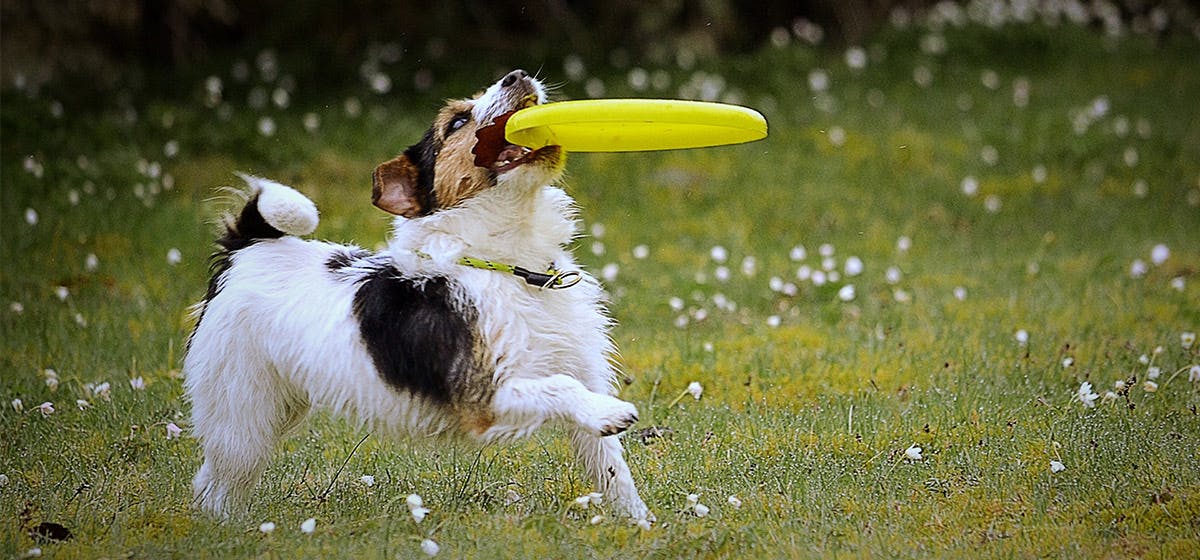
Choosing the Right Frisbee for Your Dog
Selecting a frisbee for your pup? Consider these points for a fun experience!
- Opt for one made especially for dogs - they're tough!
- Pick a size suitable for your breed to avoid choking.
- Go for a soft yet sturdy texture - to protect their teeth and gums.
- Also, choose a lightweight frisbee that's easily visible!
- Another factor to consider is your pet's play style and preferences. Does your pup like a softer or harder disc? Observe their reactions for the perfect frisbee.
An interesting fact - the concept of dogs catching frisbees began in 1974! Alex Stein and Ashley Whippet amazed a crowd with their agility - thus, canine disc sports were born.
Enjoy the bond between you and your pup through frisbee-catching!
Preparing Your Dog for Frisbee Training
To prepare your dog for frisbee training, assess their physical abilities, engage in basic obedience training, and focus on building a strong bond. Assessing your dog's physical abilities will help determine their capabilities in catching and retrieving. Basic obedience training establishes a foundation of commands and discipline. Building a bond with your dog fosters trust and cooperation throughout the training process.
Assessing Your Dog's Physical Abilities
Your pup's physical capabilities are key to successful frisbee training. Knowing its advantages and drawbacks is a must for an effective, secure program. Consider:
- Speed and agility: Check how quickly it can turn and cover distances. A fast, nimble pup is likely to ace frisbee catches.
- Jumping ability: See if it can jump high enough to grab the frisbee in the air. Dogs with good vertical jumps have a better shot.
- Endurance: Frisbee training needs stamina, so look at your dog's capacity to keep going without getting tired.
- Flexibility and coordination: Canines with great flexibility and coordination can make acrobatic catches and tricks with the frisbee.
- Retrieving skills: Your pooch should instinctively run after and bring back the frisbee. An eagerness to retrieve is essential.
Bear in mind that each dog is unique. Factors like breed, age, health, and past exercises may affect their abilities.
Don't forget mental stimulation when frisbee training. Mental challenges along with physical exercises keep your pup engaged and motivated.
Pro Tip: Consult a pro frisbee trainer for personalized guidance tailored to your pet's physical abilities.

Basic Obedience Training
Basic obedience is essential for any pup who needs to learn Frisbee. It's the base for more complex skills and keeps safety and control during their sessions.
- Teach your dog the basics like sit, stay, come, and heel. These commands give you control over Frisbee time.
- Positive reinforcement like treats and praise when they do well helps them understand that obedience is good.
- Be consistent with the commands so they understand them in any situation.
- Increase the difficulty level of the exercises to challenge them and make them more responsive.
- Be patient. Every dog learns at their own pace.
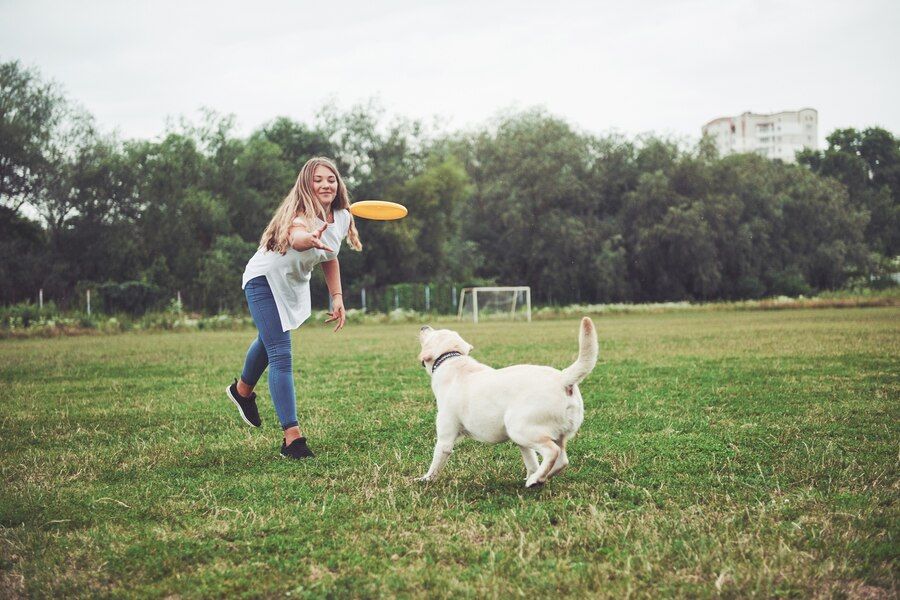
For great Frisbee training, also do crate training, impulse control exercises, play breaks, and get them used to different environments.
Crate training gives them a secure, comfy space and helps them not be destructive when left alone.
Impulse control exercises stop impulsive behaviors while playing. Like teaching them to wait patiently before chasing the disc.
Play breaks keep them from getting bored or overwhelmed.
Expose your dog to new places slowly so they can adjust and not be stressed when competing.
Follow these tips and your dog will be ready for Frisbee training. Remember to personalize the training to them and use positive reinforcement always.
Building a Bond with Your Dog
Fostering a strong relationship with your pup is essential for frisbee training success. Here are some tips to help you bond:
- 1. Spend time together: Walk or play together. This strengthens your bond.
- 2. Positive reinforcement: Give treats, praise, and affection when your pup behaves well. This reinforces trust and eagerness to please.
- 3. Understand your pup: Learn your pup's body language and cues, plus how to communicate through verbal commands.
- 4. Trust-building activities: Agility training teaches your pup to rely on you.
- 5. Consistency and routine: Stick to a schedule for feeding, exercise, and training sessions. This provides security and strengthens your bond.
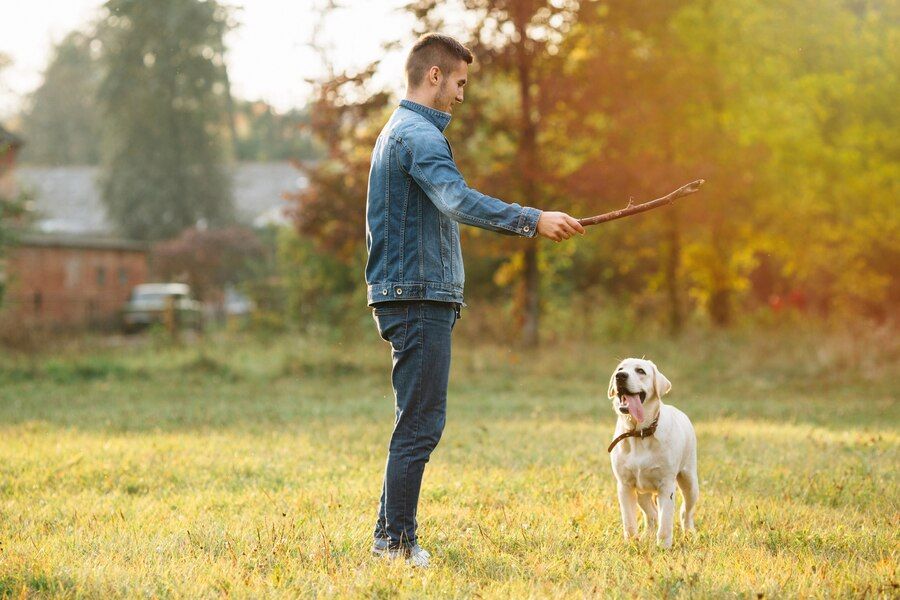
Also, be sure to take their personality into account. Bonding takes time and patience.
For great results in frisbee training, form a foundation of trust and connection. Investing in the bond increases training success and creates a deeper emotional bond.
Start building that connection now and enjoy the incredible experiences awaiting you and your four-legged bestie. Have fun, work as a team, and play lots of frisbee!
Teaching Your Dog to Catch a Frisbee
To train your dog to catch a frisbee, start with fetch exercises, introduce the frisbee, and use positive reinforcement techniques. These steps will guide you in teaching your furry friend the exciting skill of catching frisbees. Start with fetch exercises, then introduce the frisbee, and finally, ensure successful training through positive reinforcement techniques.
Starting with Fetch Exercises
To teach your pup to catch a Frisbee, follow these steps:
- Start with fetch exercises in an open space without distractions.
- Introduce your dog to the concept of fetching by using a tennis ball or toy.
- Throw the ball or toy short distances and use treats/praise when they bring it back.
- Increase the distance of your throws and help build your dog's strength and confidence.
- Once your dog is comfortable with fetching, introduce a Frisbee.
- Start with short tosses close to the ground and gradually increase the height as they become more skilled.
- Remember, consistency is key for training success!
- Use quality Frisbees designed specifically for dogs to avoid any harm during play.
Introducing the Frisbee
Throw your pup into the world of Frisbee! The iconic toy provides lots of fun and exercise, plus it's light and aerodynamic. Start with gentle throws at a short distance, and reward their efforts with treats or praise. Gradually increase the distance and height as they get more comfortable catching it.
For beginners, use a soft Frisbee designed for their teeth and grip. Practicing in an open space free from distractions will help them focus. To showcase their talent, join canine sports clubs or competitions - a great way to bond together.
Don't miss out! Introduce your pup to Frisbee today and watch them jump for joy at every airborne encounter.
Using Positive Reinforcement Techniques
Using positive reinforcement to teach your pup to catch a Frisbee can be very effective. This focuses on rewarding desirable behaviors, prompting your pup to repeat them. Some tips to keep in mind:
- Begin with basics: Ensure your pup is familiar with commands like sit, stay, and come before introducing Frisbee. This makes it easier for them to understand.
- Treats as rewards: Positive reinforcement involves treats when pup catches the Frisbee. Pick treats that'll motivate your pup.
- Small steps: To prevent overwhelming your pup, break training into small steps. Start by rewarding them for showing interest in the Frisbee, then tossing it short distances.
- Be consistent and patient: Consistency is key. Set aside time to train and be patient as pup learns. Celebrate successes and offer guidance during setbacks.
- Make it fun: Incorporate playfulness into sessions to keep pup excited and engaged. Use an enthusiastic tone, praise, & incorporate games or tricks.
To get the most out of positive reinforcement, consider the size and weight of the Frisbee that's best for your pup's breed and size. Also, practice in a distraction-free environment for better focus. Now you know the techniques and benefits of positive reinforcement - have fun and create a rewarding experience with your pup! Start today and soon you'll be amazed by pup's new Frisbee-catching skills. Enjoy the joy & excitement!
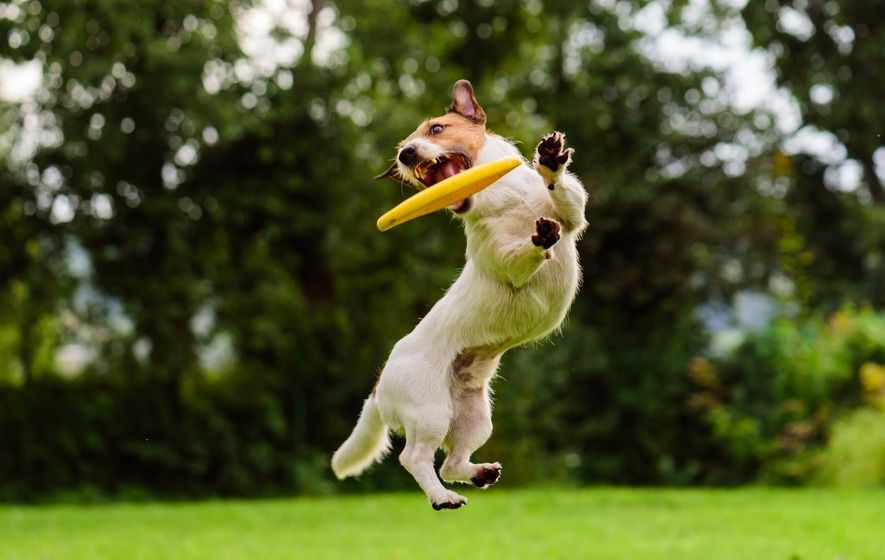
Advanced Frisbee Training Techniques
To master advanced frisbee training techniques in increasing distance and accuracy, as well as incorporating tricks and acrobatics, follow these guidelines. Achieve greater control and precision in your throws while enhancing the excitement and entertainment value of your frisbee sessions. Push your training endeavors to new heights and unlock endless possibilities for you and your canine companion.
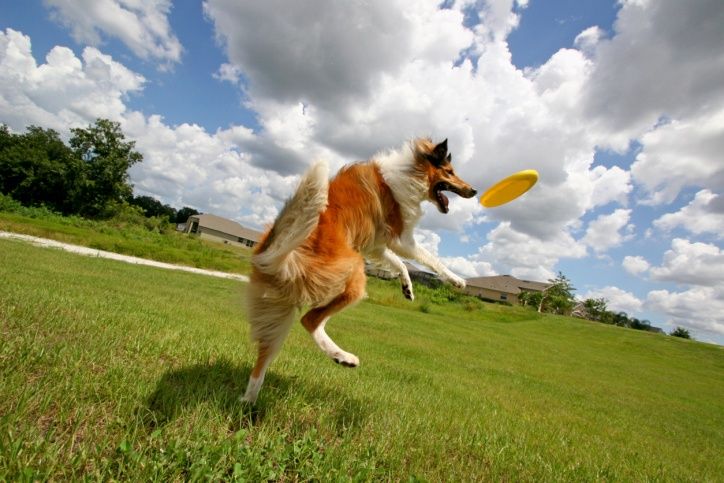
Increasing Distance and Accuracy
Distance and accuracy are essential to frisbee throwing, and require advanced techniques. Mastering these skills can give you a competitive edge on the field. Here are some steps to help enhance your throws:
- Technique: Hold the frisbee with a comfortable grip. Generate power from your legs and hips, transferring it through your core and shoulders, and releasing the frisbee with a flick of your wrist. Practice this motion to develop muscle memory.
- Strength and Conditioning: Build strength in your arms, shoulders, and core. Exercise like shoulder presses, bent-over rows, planks, and rotational movements. Do exercises that increase explosiveness, like medicine ball throws.
- Target Practice: Set up targets at varying distances. Start with bigger targets close to you, and then decrease the size as you improve. Focus on hitting the targets consistently, then increase difficulty by moving further away or angling the throws.
- Video Analysis: Record yourself throwing frisbees. Review the videos to identify errors or areas for improvement in your technique. Make adjustments based on what you observe.
To see serious improvement, stay dedicated to practice and self-improvement. A local frisbee team had been struggling, so they implemented a rigorous training program. After weeks of practice and video recordings, they noticed remarkable improvements in their throws. Their long passes became more precise and consistent, which led to important victories against tough opponents.
These methods can help you excel in your frisbee throwing abilities. So grab your frisbee, start practicing, and watch as your throws reach new heights!
Incorporating Tricks and Acrobatics
Add an extra twist to your throws! Jump in the air and rotate your body for a move that will leave defenders in awe. Impress everyone with your agility by catching the frisbee behind your back. For a real showstopper, dive through the air and catch the frisbee mid-flight. Surprise your teammates with an overhead kick pass. Master the one-handed spin technique to add flair to your throws. Try reversing your throws too.
Mix these tricks and acrobatics during practice sessions to unleash an unpredictable arsenal of moves. Not only will this add style to your game, but it will also boost team morale and spectator excitement. So why wait? Start mastering these advanced frisbee training techniques today and join the ranks of elite frisbee players. Take your game to the next level!
Safety Precautions
To ensure safety while training your dog to catch a frisbee, follow these key precautions. Selecting a safe training environment and avoiding overexertion and injury are vital. Creating a secure space and being mindful of your dog's physical limits will help prevent accidents and ensure an enjoyable training experience for both you and your furry friend.
Selecting a Safe Training Environment
Choosing a secure training setting is essential for guaranteeing the welfare and prosperity of those taking part in various training plans. Consider these 6 significant focuses when settling on a safe training environment:
- Location: Select an area that is available and has appropriate transportation offices to guarantee comfort and participation.
- Facilities: Search for all around kept up offices with sufficient space, ventilation, lighting, and fundamental hardware to improve the training experience.
- Safety Measures: Prioritize security by picking an environment with legitimate crisis exits, fire dousers, first aid kits, and safety conventions set up.
- Instructors: Evaluate the capabilities and experience of the mentors who will give the training as their insight is basic in making a safe learning environment.
- Cleanliness: Cleanliness is fundamental for forestalling the spread of contaminations. Guarantee that the training environment keeps up elevated requirements of tidiness and cleanliness.
- Feedback and Reviews: Look for input from others who have utilized the training environment to measure its appropriateness and security record.
Note that apart from these points, thinking about any extra special subtleties will help make an informed decision about the selection of a safe training environment.
A genuine story stressing the significance of choosing a safe training environment includes somebody going to a wellness class at an over-crowded studio with poor ventilation. As temperatures rose during one session, several participants experienced heat exhaustion. This occurrence underlines how significant it is to prioritize security when picking a training environment.
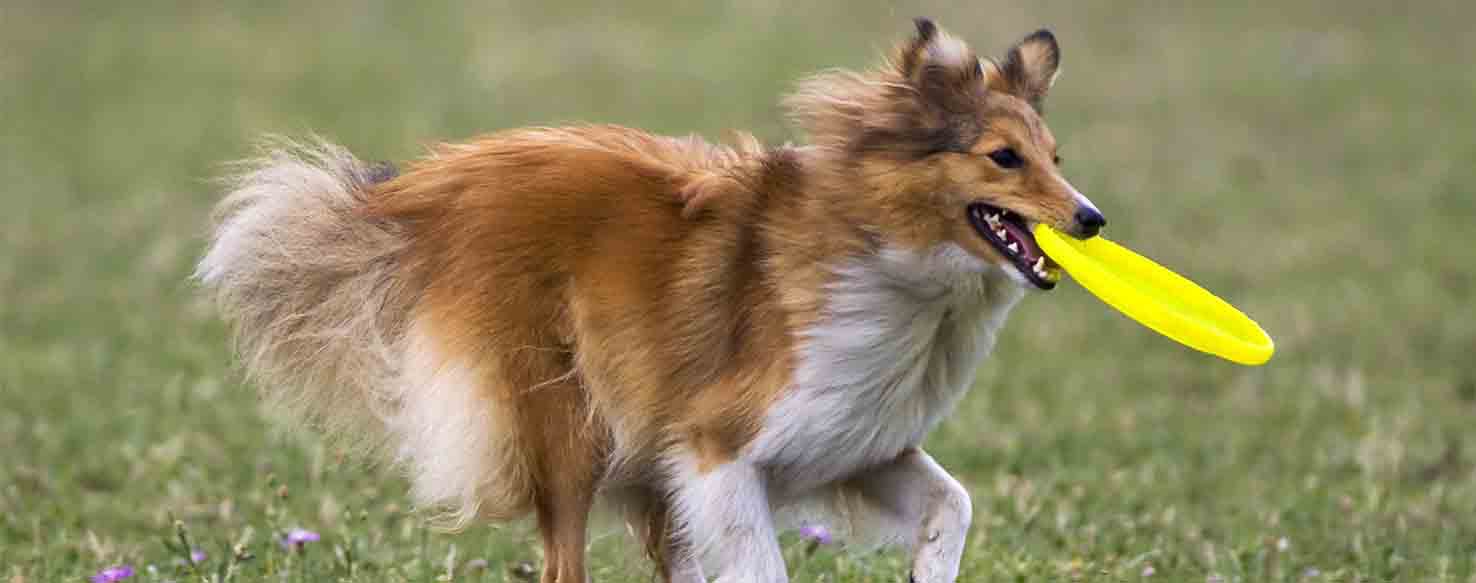
Avoiding Overexertion and Injury
To keep a safe environment, it's important to remember these three points:
- Understand your limits: Recognize your physical abilities to prevent overexertion. Don't go beyond what you can handle - it may lead to injuries.
- Use the right technique: When doing sports or lifting objects, use the correct form and technique to lower the risk of injury. Ask professionals for help if needed.
- Take breaks: Resting regularly restores your body and helps prevent fatigue-related accidents. Plan your activities to make sure you have time to relax.
To be more cautious, consider these tips:
- Wear protective gear: Depending on the activity, helmets, gloves, or knee pads can protect you from potential harm.
- Do warm-ups and cool-downs: Before physical exertion, do warm-up exercises to prepare your muscles. Cool-down exercises help decrease heart rate and reduce muscle soreness.
- Pay attention to your body: Watch out for warning signs such as pain, dizziness, or shortness of breath. Ignoring these can have severe consequences. Respect your body and seek medical advice if necessary.
Follow these steps to create a safer environment for yourself and others. Keeping yourself safe not only supports your physical health, but also increases productivity and enjoyment. Stay alert and prioritize safety always.
Troubleshooting and Common Challenges
To tackle troubleshooting and common challenges in training your dog to catch a frisbee, equip yourself with effective solutions for overcoming fear or reluctance and dealing with disinterest or lack of progress.
Overcoming Fear or Reluctance
Feeling scared of something new? It's normal. But growth and progress require us to leave our comfort zone. Change the way you think! Don't focus on negative possibilities - look at the chances that may come. Being positive will help. And remember to reach out for support - mentors, groups or close ones. Break down the challenge into tiny steps and celebrate each victory. Learn from history - e.g. Amelia Earhart. She flew solo across the Atlantic despite obstacles and norms. Let her inspire you to face your own fears.
Dealing with Disinterest or Lack of Progress
When dealing with disinterest or lack of progress, it's important to employ successful strategies. Four major points to consider:
- Create an open atmosphere for communication. Listen and cooperate to find solutions.
- Clarify objectives and direction. Break large tasks into small ones.
- Acknowledge successes and rewards. Appreciation can boost morale.
- Try new approaches if needed. Technologies, gamification, or workflow.
Encourage collaboration and brainstorming. Involve individuals in decision-making and offer incentives. Take action now! Inspire enthusiasm and nurture progress towards your goals.
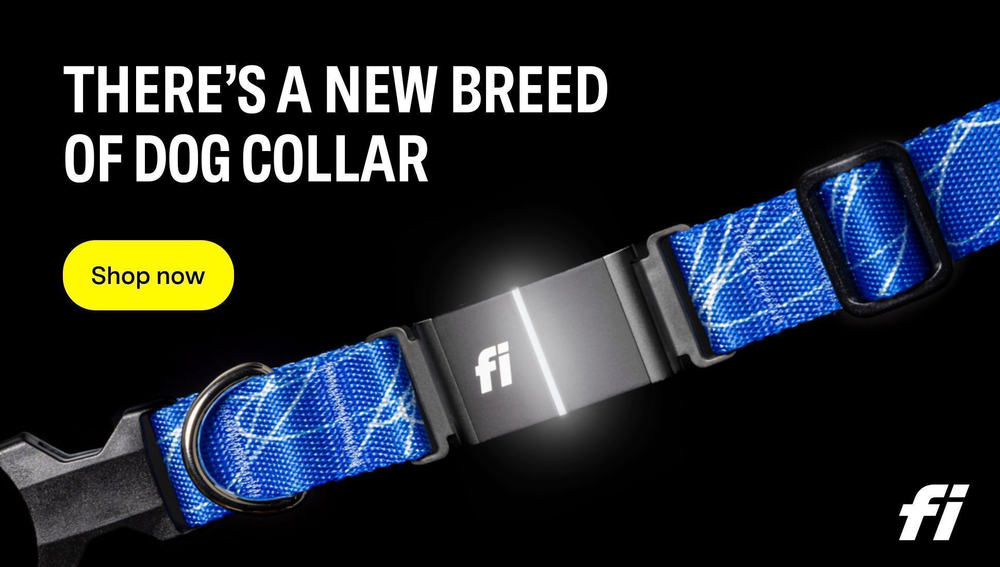
Conclusion
Consistency and patience are essential to training your pup to catch a frisbee. Start with basic retrieve commands, and slowly add the frisbee. Reward your pet's progress with positive reinforcement. Each dog is different, so it may take time for them to learn.
Account for your dog's physical abilities. Some breeds are naturally better at frisbee catching, while others need more practice. Personalize each session to suit your pup.
A strong bond is important too! Spend quality time with your dog both on and off the field. This will help improve their performance and make training fun.
As an example, I once met a rescue dog named Max. He had never played with toys, or with a frisbee. But, with consistent training over months, he became an expert catcher! It was amazing to see his transformation.
Don't be discouraged if your pup doesn't catch on right away. With dedication and guidance, they can learn this skill too. Have fun and celebrate each small success. Happy training!
Frequently Asked Questions
Q: How do I start training my dog to catch a frisbee?
A: To start training your dog to catch a frisbee, first introduce them to the frisbee in a positive and fun way. Allow them to sniff and investigate the frisbee, and then gradually introduce throwing it short distances for them to chase. Reward them with treats and praise when they show interest in the frisbee.
Q: Can any dog breed learn to catch a frisbee?
A: Most dog breeds can learn to catch a frisbee. However, some breeds are more naturally inclined towards this activity, such as Border Collies and Australian Shepherds, due to their herding instincts. Regardless of breed, patience, consistency, and positive reinforcement are key ingredients for success.
Q: How can I teach my dog to catch the frisbee in mid-air?
A: Teaching your dog to catch the frisbee in mid-air requires progressing gradually. Start by tossing the frisbee low and close to your dog, gradually increasing the height and distance of throws as their catching ability improves. Use positive reinforcement, like treats and enthusiastic praise, each time they successfully catch the frisbee.
Q: What if my dog is afraid of the frisbee?
A: If your dog is afraid of the frisbee, it's important to go at their pace and not force them to interact with it. Start by keeping the frisbee nearby and rewarding your dog for any interaction, such as sniffing or touching it. Gradually work towards throwing short distances once they become more comfortable. Seek guidance from a professional dog trainer if needed.
Q: Are there any safety precautions I should take while training my dog to catch a frisbee?
A: Yes, it is important to ensure a safe environment during frisbee training. Choose an area free from hazards like sharp objects or slippery surfaces. Use a frisbee specifically designed for dogs to minimize the risk of injury. Additionally, regularly check your dog's paws for any signs of irritation or injuries caused by repetitive jumping and catching.
Q: How long does it usually take to train a dog to catch a frisbee?
A: The time it takes to train a dog to catch a frisbee can vary depending on the individual dog's age, breed, temperament, and previous training experiences. Some dogs may learn quickly within a few weeks, while others may take several months of consistent training. Remember to be patient, consistent, and celebrate small achievements along the way.




